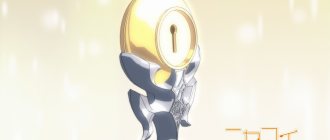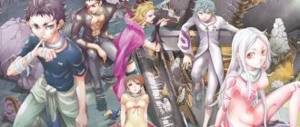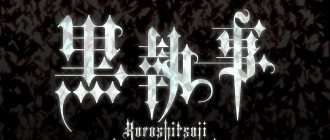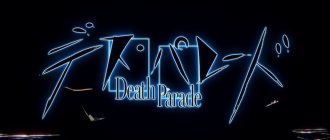Time travel has been of interest to humanity for a long time. I’m sure each of us at least once in our lives thought about what we would do if we got the opportunity to travel to the past or future. Some people dream of returning to the past to correct their mistakes, others to the future to see what the world will be like in thousands of years. Hundreds of books have been written on similar topics, hundreds of films have been made, and there are even quite serious scientific theories and justifications for time travel. It is quite predictable that such a pressing topic did not pass by the anime. In the current review, I will tell you about an extremely successful anime, the action of which takes place around a time machine - Steins ; Gate (“Stein’s Gate”, “Steiner’s Gate”).
Brief information
“Stein's Gate” is a 24-episode anime released in 2011, based on the visual novel . White Fox studio . In addition to the series, a full-length film was released called “Steins;Gate: Fuka Ryōiki no Déjà vu” , which is worthy of a separate review. A manga has also been released based on the Steins Gate universe. The word “Stein” in the name comes from the name of Albert Einstein, the author of the theory of relativity, various aspects of which are associated with travel in time and space.
Time Machine. Hearing this phrase, you begin to imagine complex and massive metal structures with a bunch of different sensors and switches. However, the brilliant brain of self-proclaimed mad scientist Okabe Rintaro (aka Okarin, aka Kyouma Hooin) thinks otherwise. He and his faithful assistants in the person of the frivolous girl Mayuri Shiina , the fat hacker Itaru Hashida and the girl genius Kurisu Makise developed a device based on an ordinary microwave, thanks to which you can send short text messages to the past. By sending such a message, you can completely change the past, present and future. Just one sentence that can change the world...
It is no coincidence that I called Steins;Gate an extremely successful anime : it consistently ranks in the top ten in all kinds of world rankings. In the same ranking of the World Art website at the time of writing the review, Steins ; Gate were in second place. There are a number of reasons why this anime is so beloved by fans around the world, from its characters to its rich story. So, first things first.
"Guide to Stein's Gate." Steins;Gate review and reading tips
“The universe has a beginning, but has no end—infinity. Although the stars also have a beginning, they perish under their own power - limitation. History has proven that the wisest man is the greatest fool. A fish living in the sea does not know about the world on land. She would have died the same way if she had gained this knowledge. A man who exceeds the speed of light is more absurd than a fish who began to live on land. One could say that this is God's last warning to those who resist."
These words may seem like philosophically interesting thoughts, or they may seem like pretentious nonsense.
What we can say for sure about them is that they belong to a student at Tokyo Denki University. Despite this, the student is the founder of the Future Gadgets laboratory, a self-proclaimed mad scientist whose goal is to destroy the world order. His name is Hooin Kyouma (Fatal Phoenix). His middle name, according to Kyouma, is used to "deceive the world": Okabe Rintaro. The main character of the visual novel (novel) Steins;Gate
, manga, its anime adaptation, continuation and spin-offs.
Steins;Gate
belongs to the
Science;Adventure
, but in general its story is independent.
S;A
Universe incorporates various conspiracy theories into the plots of its works.
S;G
is the most popular among them. One of the reasons for this is the excellent anime adaptation, which served as an advertisement for the novella for many. The other lies in the main theme of the work: “Time Travel.”
Coming up with something new and, more importantly, interesting with such a concept is a difficult task, but with sufficient experience and desire it is quite doable. The authors provide an unusual model of “time” that actually works within the universe, and build the entire plot around it. The characters in it are ordinary people who obey this model. The main character had the opportunity to control time. But it turns out that this possibility is imaginary.
The twenty-eighth of July two thousand and ten. Japan, Akihabara. Crazy mad scientist Hooin Kyouma heads to the Radio Center for Dr. Nakabachi's conference. His childhood friend Shiina Mayuri, a carefree, kind schoolgirl, went with him and asked about the purpose of the trip only in the building itself. The goal is the topic of the presentation. "Time travel". Kyouma, of course, is skeptical about what Nakabachi has to say, but still decides: a) that this is interesting information; b) what needs to be known about it before the Organization. The presentation had barely begun when the entire building shook for a short time. One might have thought it was an earthquake, but Kyouma identified the source of the shaking on the roof. Having opened the door there, he discovered, presumably, a satellite. Many questions appeared in Kyouma's head, but he did not dare to find answers to them. A building employee escorted the concerned people off the roof. After the presentation, the material of which turned out to be plagiarized, a disappointed Kyouma was about to leave with Mayuri, when suddenly a scream full of pain rang through the entire building. Hooin sends his friend outside, and he goes to check the source of the scream.
On the eighth floor of the Radio Center, Okabe Rintaro witnesses a murder. Not noticing the people screaming, he runs out of the building in horror, meets with Mayuri and, having told her everything, decides to go with her back to the laboratory. Along the way, Okabe began writing a message to his comrade Hashida Itaru to tell him about this too. He finishes the letter, presses the “Send” button and...
Mysterious numbers flash before the reader/viewer, and an empty street appears before Rintaro, which a second ago was crowded. Okabe runs in search of Mayuri and the rest of the people. He finds her at the Radio Center and asks her in bewilderment about what happened. According to Mayuri, she and him were just approaching the Radio Center. Okabe turns his gaze to the building: the satellite that was previously on the building was now inside it, as if it had fallen from a height. By this point, the reader/viewer has too many questions. What are these numbers? Where have all the people gone? What kind of satellite is it and why did it crash into a building, although it was standing on it a couple of minutes ago? Who committed the murder and why? What kind of Organization is Hooin talking about? And why does he act like a narcissistic idiot chunibyo (see “eighth grader syndrome”)?
There is no point in revealing the entire plot. In the next few hours of reading/several episodes of watching, only a few questions will be answered, but nothing in the future will be left unanswered. And after one plot twist, the tone of the story will completely change, and then the true face of Steins;Gate
. But first and foremost, this is a story about characters. It makes sense to talk about them.
Okabe Rintaro, aka Lab 001 employee and crazy mad scientist Hooin Kyouma. An eccentric, according to many people, but quite harmless, so as not to throw him out of a rented one-room apartment. He gave it the loud name “Laboratory of Gadgets of the Future.” And since Kyouma is a scientist, he wears a lab coat all the time. In addition, he established a dress code in the laboratory, according to which all employees must wear lab. robe, but almost no one follows it. Likes to use names from Norse mythology in his "operations", even if their goal is to reduce the cost of beef. When conducting them in emergency and not too serious situations, Kyouma uses his assistant, with whom he confers and shares information. Mobile phone. Even if it's turned off. But the mad scientist also knows how to use it properly. Comes up with nicknames for people. He is hiding from the Organization, which only he and no one else knows about, and is fighting with the whole world. Kyouma is not crazy, he understands what he says and does. But the reason for his behavior will remain a secret to the reader/viewer until the right moment.
Shiina Mayuri, aka Mayushi and laboratory employee 002. A kind, caring, carefree, stupid girl. He has been friends with Okabe since childhood. Perhaps for this reason she became the second employee: one spring day, Mayuri simply came to the laboratory to visit a friend. Since then, she has been visiting the “lab” every day as an employee, despite the fact that she is not mentally equipped to work on Future Gadgets. But Mayuri spends her time sewing costumes for her cosplaying friends, but she doesn’t want to cosplay herself. Works at the MayQueenNyan² maid cafe.
Hashida Itaru, aka Daru, employee of laboratory 003, super-haka (as Kyouma calls him), super-hacker (as he calls himself). Specialist in software, hardware and Japanese memes. High level otaku. In his speech he uses stable expressions and phrases that are references to various anime/manga/games. A regular on the Japanese imageboard is @channel (“@” is read as “at”). I became an employee for several reasons: a) you can freely use the computer in the lab; b) it’s a relatively short walk to that very maid cafe.
Makise Kurisu, aka "The Zombi", "Celeb 17 (Seventeen Year Old Star)", perverted genius girl, American Virgin, "@chaneller", tsundere, assistant and Christina. (If the meaning of all the other nicknames is revealed in the plot, then “Christina” needs to be explained. Kyouma pronounces “Kurisu-tina”, which sounds like “Christina”. Kurisu always responds by noting that there is no “-tina” in her name. ) Kurisu is a young brilliant scientist. At the age of seventeen (she is already eighteen during the plot), her article was published in the popular science magazine Science. The reader/viewer, like Kyouma, gets to know Kurisu better during her lecture. Lecture topic: “Time Travel.” But it would be more accurate to say: “Why time travel is impossible.” Her arguments are logical, her arguments are firm, and her views are indestructible. This unyielding nature makes her very difficult to get along with.
Kiryu Moeka, aka Sparkling Finger. She received her nickname for her incredibly fast handling of the phone. SMS messages replace verbal communication for her. Moeka is almost always silent, and when she speaks, she does it very quietly. Journalist, works at Arc Rewrite. At the time of the plot, he is searching for a rare computer IBN 5100.
Urushibara Ruka, aka Rukako. Helps her father by working as a miko (priestess) in his temple. Trains with teacher Kyouma in handling the Demonic Sword Samidare. Quiet.
Feyris Nyan-Nyan, aka Feyris. She manages and works at the MayQueenNyan² maid cafe. This cafe is an otaku paradise, and Faris treasures it very much. She is the object of Daru's adoration. Since Faris is a chunibyou, she is the only one who can communicate freely with Kyouma (this makes Daru very jealous of Hooin). But the scientist is not particularly enthusiastic about communicating with her and calls her nothing more than a “lying woman.”
Amane Suzuha, aka Part-Time Warrior. Arriving. Calls himself a Warrior and works part-time at Tennoji's store selling CRT TVs (very old TVs).
Tennoji Yugo, aka Mister Brown. He rents out the very apartment in which Kyouma founded his laboratory. It is located directly above the CRT-TV store. The relationship between Kyouma and Tennoji is a little tense: the landlord does not like the behavior of the mad scientist, and threatens to raise the rent in response to any of his tricks. Raises his daughter Nae.
Laboratory of Gadgets of the Future, aka Lab.
It doesn’t look like a laboratory at all, but there are gadgets, and at the time of the plot, as many as eight have been invented. For example, the very first one is a TV remote control in the shape of a toy alien gun. Its disadvantage is that it only changes channels forward, and you have to manually turn on the TV or even adjust the sound on the TV. This trend can be seen with all gadgets. Their names are references to anime and games (there is also a Jo-Jo reference). Some people who decided to check out Steins;Gate
have two main complaints: nothing happens for a very long time and nothing is clear. Such statements do occur, so it is necessary to explain why the authors did so.
A “drawn-out” introduction (slightly less than half of the entire plot before the plot) is necessary for the player/viewer to get used to the characters and for the plot to line up smoothly, logically, without abrupt transitions. There are practically no unnecessary scenes. The introduction also asks many questions that will be answered much later. For certain of them - in the very finals. There is also a mostly subjective complaint that it is impossible to understand the main character. “He is carrying some kind of far-fetched nonsense of a schizophrenic that does not fit with logic and his actions”
,
“Gg is such an asshole”
and the like.
As has already been written: in Steins;Gate
there is an explanation for everything, but it may not be given for a very long time. This also applies to the main character.
Where exactly to start getting acquainted? To be honest, I recommend watching the anime adaptation first rather than reading the novel. No wonder it was said that the adaptation is excellent. She misses many interesting moments and adds gags that were not in the original; makes the two well-written minor characters from the novella a bit simple. But despite this, the adaptation perfectly conveys the spirit of the original and basically follows the novel. Moreover, viewing it takes much less time.
Familiarization procedure
1.
Steins;Gate
(novel/serial adaptation) 2.
Steins;Gate 0
(novel/episode 23β + serial adaptation) 3.
Steins;Gate The Movie - Load Region of Déjà Vu
(feature film) 4.
Steins;Gate The Distant Valhalla
(novel)
Some components
About
Steins;Gate
: 24 episodes + 25 OVAs;
There are post-credit scenes that you need to watch to understand the plot; The crack for the novel is in the Steam manuals. About Steins;Gate 0
: 23 episodes + 24 OVAs;
episode 23β is a prequel to the events of " Zero
";
the plot of “ Zero
” is completely based on the plot of
Steins;Gate
(that is, to understand it you need to know the events of the original);
There are also post-credit scenes; The localization language for the novella is not ready yet. About Steins;Gate The Movie
: continuation of the story of
Steins;Gate
.
About Steins;Gate The Distant Valhalla
: the crack is available on the Internet;
The plot is completely based on the original. Steins;Gate
is an extraordinary experience.
Many people agree that this is the best thing they have seen. But even otherwise, a person does not remain indifferent. Fan bases are formed, debates flare up on the topic “Is Zero
than the original/is the film canonical,” fan theories are built about the few moments that
Steins;Gate
is silent about.
Some will continue their acquaintance with the Science;Adventure
and begin reading other works.
And even fewer people will immediately go to reread/rewatch Steins;Gate
. This concludes my report. The "Reverse Trojan Horse" mission is completed. Use this important report in your fight against the Organization. Good luck.
El...
Psy...
Kongru...
Video version here... yay
LabMem Shanti for help in text editing and LabMem LastStepToHell for help in text design and GIF animation
We follow blogs and you
review, steins;gate, my first review, exciting, great step for a great man, best, visual novel
Write a comment Total comments: 54
Important Notations
There are a number of different names that appear in the anime that require explanation:
CERN. The abbreviation CERN comes from the French C onseil E uropéen pour la R echerche N ucléaire (European Council for Nuclear Research). It is the world's largest high energy physics laboratory located in Europe.
TANK. The Large Hadron Collider. A special device owned by CERN and designed to accelerate nuclear particles.
Kyouma Hooin. This is what the main character of the anime, Okabe Rintaro, asks himself to call himself. Translated into Russian it means “Phoenix of Cruel Reality”, or “Fatal Chimera”. Pathos, pathos.
John Titor. A time traveler from the future. On American forums in 2000-2001, a person appeared who claimed that he had arrived from 2036. So the basis was a very real case.
El Psy Congroo. Okabe often says this phrase. It is a combination of Greek and Latin, and means “To Harden the Mind.”
Anime Amino
~STEINER'S GATE~
Before I start, I will write why I like this anime.
1
A fascinating plot. Everyone writes that they became interested in this anime from episode 8. And I was captivated by this creation from episode 1. Questions immediately appeared that the author had no intention of answering yet.
2
Well-developed characters. Here, each character is developed according to the plot. Their stories are told, their character and difficulties in life are told.
3
Impression. This was my first anime, so it left a lasting impression. I was giving birth, not just crying, I was screaming. I was happy, I was sad. In this anime there are moments where you can laugh, swim and bark.
♡GENERAL INFORMATION♡
Stein's Gate is a Japanese visual novel created by 5pb. and Nitroplus, the second in the Science Adventure series. The plot takes place a year after the events described in the game Chaos;Head. The Xbox 360 version was released on October 15, 2009, and the Windows version on August 26, 2010.
The first manga adaptation of the game with illustrations by Sarachi Yomi began appearing on September 26, 2009 in Media Factory's Monthly Comic Alive magazine, the second, Steins;Gate: Boukan no Rebellion, centered on the character Suzuha Amane, with illustrations by Kenji Mizuta - from December 28, 2009 of the year in Monthly Comic Blade magazine. The anime series based on the game's plot was broadcast from April to September 2011. Steins;Gate also has a spin-off sequel called Steins;Gate 0.
An anime and a visual novel have been announced for release. The action takes place in the Beta attractor field, where an alternative development of the original plot is shown. The events of the sequel are based on the previously released light novels and drama discs, but significantly edited and expanded. The sequel was released on December 10, 2015 on the PS4, PS3 and PS Vita platforms. On September 9, 2021, the game appeared on the Steam service.
♢NAME♢
According to the anime's writer, the word "Stein" is inspired by the name of Albert Einstein, one of the authors of the theory of relativity, the implications of which are often used in the work. In the game, the phrase “Gate of Stein” (Japanese: シュタインズ ゲート) is written using kanji,
as "Gate of the Stone of Destiny" (Japanese, 運命石の扉 Ummeiseki no Tobira). The hieroglyph for stone was chosen because the word "Stein" is translated from German as "stone"; and the word "fate" is simply added for added effect.
♧A LITTLE ABOUT THE GAME♧
Steins;Gate's gameplay requires little interaction from the player, as most of the game's time is spent reading text that appears on the screen, which is either dialogue between various characters or the thoughts of the protagonist. Like many other visual novels, there are certain points in Steins;Gate where the player is given choices that affect the game's storyline.
For these decision points, Steins;Gate provides the player with a "telephone trigger". When the player receives a challenge from someone, they can choose to answer or ignore the challenge. Received text messages will have certain words underlined and appear in blue (much like links in the browser) that allow the player to choose how to respond to the text message.
Most phone calls and text messages do not require responses or responses are of little significance, although there are certain points in the game where the player needs to take action. Depending on the player's choices (how he reacts to these calls and text messages), the plot will develop in a certain direction.
♤PLOT♤
18-year-old Rintaor Okabe is a slightly insane scientist eager to uncover a global conspiracy and build a time machine. To this end, he creates the “Laboratory of Time Problems” - a shelter and outlet for all those who miss crazy adventures and crazy ideas.
The crazy Okabe is joined by hacker Itaru Hashida, an ardent otaku and food lover. The good-natured Mayuri Shiina, the longtime friend of the main character, who loves cosplay and adventure, does not stand aside.
With the arrival of the young genius Kurisu Makise, a motley group of cheerful eccentrics creates a real time machine and embarks on the path of great achievements. Only a bunch of mistakes and unforeseen situations make Okabe greatly regret opening the “Stein’s Gate”...
~LOTS OF SPOILERS FROM THIS POINT~
₩TERMINOLOGY₩
D-mail is a text message sent back in time to change the course of history.
Reading Steiner is an ability that allows a person to retain memories of events that happened to him in other time branches. Present in every person, however, it is most pronounced only in Rintaro Okabe (due to a serious illness), allowing him to retain clear, undistorted memories of events that occurred on other time branches. For others, “Reading” manifests itself in the form of déjà vu or dreams. For example, Mayuri had dreams in which she died every time in front of Okarin, and Kurisu has vague memories of her own death.
This happens because the totality of incidents that happen to a certain person, as well as his (person’s) memories, forms a different personality on various time branches. (From the film) Also, a side effect of “Reading Stein” is the possibility of moving to other time lines if the owner does not fully believe in the reality of what is happening on the line he has chosen. For example, Rintare Okabe in the full-length film transferred from the Stein Gate line to the G line, which differed from the first by 0.01% (convergence percentage).
John Titor is the pseudonym of time traveler Suzuha Amane. Corresponds to the real prototype of a stranger who appeared on American forums in 2000-2001, claiming to have arrived from 2036. Later he became an Internet meme.
■CHARACTERS■
Rintaro Okabe
— Age — 18 years. A student at the University of Tokyo. Member of the Future Gadget Laboratory No. 001. A young man who claims to be a crazy but brilliant scientist. He often uses the pseudonym Kyouma Hooin. He is also known among his friends as Okarin: that’s what Mayuri called him by combining the first parts of his surname and first name - Okabe Rintaro.
Constantly talks about some mysterious “Organization” that is watching him; talking to himself on the phone, accompanying the above actions with crazy laughter. Founder of the Future Gadget Lab in Akihabara, where he spends most of his free time.
Always dressed in a white lab coat. He has a unique ability to remember the events of previous realities (world lines) after distortions, unlike other people, which he gave the name “Reading Steiner”.
Voiced by Mamoru Miyano
Mayuri Shiina
— Age — 16 years. Member of the "Laboratory of Future Gadgets" No. 002. Rintaro's slightly frivolous childhood friend. She creates cosplay costumes and works part-time at a maid cafe (a cafe where waitresses dress in maid costumes).
Voiced by Kana Hanazawa
Itaru "Daru" Hasid
— Age — 19 years. First year student at Tokyo Electrical Engineering University. Member of the "Laboratory of Future Gadgets" No. 003. A hacker with an excellent understanding of both computer hardware and software. I am also familiar with everything related to Topku culture.
Voiced by Tomokazu Seki
Kurisu Makise
— Age — 18 years. Member of the Future Gadgets Laboratory No. 004. A talented neuroscience researcher at an American university. When she was 18 years old, her research was published in the world-famous journal Science (in the anime the title was changed to "Science"). Okabe often calls her his assistant or his invented nickname - Kuristina or Christina (Kurisu herself is very annoyed by this).
Her father, a physicist, sees her as a rival, which is why they do not get along with each other. As a child, she always loved to listen to him talk about his work, and by the end of elementary school she could already understand the essence of his research. Then she started her own and received several awards. She always liked to argue with her father.
They corresponded constantly by mail, and the arguments became increasingly heated. But ultimately, her father stopped arguing with her, since Kurisu found errors in his calculations over and over again and, without noticing it, struck a blow to his pride. He began to take out all his anger on Kurisu's mother. He lost self-confidence and constantly moved away from his academic friends. The last time Kurisu saw her father, he told her, “Do you feel sorry for me? Are you looking down on me? You are my daughter, how dare you?!”
Okabe decided that he would reconcile Kurisu with her father. She believed that if she could make equipment to travel through time, her father might go crazy. With each of his new discoveries, Kurisu always calls his mother so that she finds out everything first.
At first glance, she is a calm girl, blushing if someone unfamiliar comes too close to her, but at heart she is the complete opposite: she once forced Ocarina to kneel for 3 hours straight, while threatening to hit him with a book. Kurisu always stands her ground, doesn't like to lose, and doesn't like when anyone tries to control her. In episode 22, Okabe's declaration of love was reciprocated.
Voiced by Asami Imai
●Other characters●
Moeka Kiryu
— Age — 20 years. Member of the Future Gadget Lab No. 005. A girl who met Rintaro in Akihabara. Extremely treasures his cell phone and gets very excited when anyone touches it. She is very shy, and therefore prefers exchanging emails to real communication.
Voiced by: Saori Goto
Hand of Urushibara
— Age — 16 years. Member of the “Laboratory of Future Gadgets” No. 006. An attractive young man with feminine facial features and character, due to which he is often confused with a girl, wears clothes characteristic of miko (temple servants). Mayuri's close friend. Despite popular misconception, this character's name is Ruka (Luka is a misspelling of his name; this is the name the character would have had if it had been written in katakana rather than hiragana).
Voiced by Yu Kabayashi
Faris Nyan-Nyan, real name Rumiho Akiha
— Age — 17 years. Member of the Future Gadget Lab No. 007. Works at the Mayqueen Nyan-Nyan maid cafe and is the most popular waitress there. She has outstanding abilities in the game RaiNet Access Battlers, which is why she has not experienced a single defeat in it.
Voiced by Haruko Momoi
Suzuha Amane Age
— Age — 18 years. Member of the Future Gadget Lab No. 008. Works part-time for Rintaro's landlord. Loves to ride a bike. A time traveler from the future. Itaru’s daughter, and judging by a hint from a stranger, Okabe met in America - he confused her with Amane (she was predicted that she would get married and give birth to a child within seven years - it was after this time that Amane should appear ). The central character of the Steins manga; Gate: Bōkan no Rebellion.
Voiced by Yukari Tamura
Yugo Tennoji
— The owner of the house where Okabe rents an apartment. Owns a TV repair shop. Lives with his daughter Nae. Rintaro gave him the nickname "Mr. Brown" for his passion for television's cathode ray tubes.
Voiced by Masaki Terasoma
Nae Tennouji
- Yugo's daughter, who lives with him in the workshop. Nae communicates well with Mayuri. Appears in Robotics;Notes as a member of JAXA.
Voiced by: Ayano Yamomoto
#MANGA
On September 26, 2009, a manga adaptation with illustrations by Sarachi Yomi began serialization in Media Factory's Monthly Comic Alive magazine. Although the manga was published before the visual novel, the story is inspired by the game.
In addition, there are four more variations of the manga story.
Steins;Gate: Bōkan no Rebellion, with illustrations by Kenji Mizuta, began serialization in Mag Garden's Monthly Comic Blade in February 2010. The manga centers on Suzuha Amane and is told from her point of view.
Steins;Gate: Onshū no Braunian Motion with illustrations by Takeshi Mizoguchi is published in the webzine Famitsu Comic Clear, told from the perspective of Yugo Tennouji.
Steins;Gate: Shijō Saikyō no Slight Fever, with illustrations by Yuzuhara Morita, began serialization in Kadokawa Shoten's Comptiq magazine in February 2011, and moved to Monthly Shonen Ace in October 2011. The manga centers on the main character, Kurisu Makise, from her point of view. Steins;Gate: Hiyoku began serialization in Comic Blade in August 2011.
Steins;Gate: Hiyoku Renri no Sweets Honey began serialization in Comic Blade in August 2011.
A comedy spin-off manga called Steins;Gate! with illustrations by Nini, began publishing in Media Factory's Monthly Comic Alive magazine in March 2011.
A book containing information and designs for Steins;Gate was published by Enterbrain on February 26, 2010.
#ANIME
On July 25, 2010, Chiyomaru Sikura announced on his Twitter page that the game Steins; Gate will be adapted into an anime. More detailed information about the adaptation became known in September 2010 from Newtype and Comptiq magazines. The adaptation was produced by White Fox and aired in Japan on April 5, 2011. The directors of the Steins Gate anime were Hiroshi Hamasaki and Takuya Sato, the screenwriter was Jukki Hanada, and the composers were Takeshi Abo and Jun Murakami. In June, Funimation Entertainment licensed the English-language series in North America.
On February 22, 2012, the ninth Blu-Ray released a special episode about Okabe, Daru, Mayuri and Ruka's journey to America, entitled "The Poriomania Epidemic".
At the end of episode 24, a ten-second teaser was shown announcing the filming of a full-length anime.
Characters
I didn't personally like all the characters (a guy who looks like a girl - how corny...), but there is no denying the fact that each of them fit perfectly into the world of Steiner's Gate. Each hero fulfills a clearly defined plot role; remove any of them and the plot will lose some of its versatility and depth. It's not often that you come across an anime that doesn't have a single passable character. Even minor characters are given one or two episodes each, in which they come to the fore and reveal their full potential. And the main character is the icing on this cake.
All the coolness of Okabe Rintaro lies in all sorts of little things: talking on a switched off phone, shouting strange phrases, constantly drinking Dr. Pepper, and, of course, an ominous laugh. All these details, bit by bit, make up a very high-quality and original protagonist, who is interesting to watch and with whom you want to empathize. Yes, he is strange, but behind this strangeness you can see a real person. First of all, this is manifested in his attitude towards his friends: even though Okabe wants to seem crazy, he really values the people around him. Especially Mayuri.
By the way, a few words about Mayuri . No matter what anyone says, she was the main character of “Stein’s Gate” for me. She, not Kurisu Makise. Apparently, I was too tired of tsunderes in the leading roles, so Mayuri turned out to be a breath of fresh air. Just a sweet and kind girl, taken hostage by a mad scientist who didn’t want her to dissolve into space and go to heaven. The scene in the cemetery seemed almost the best in the entire series.
|~~|
Mayuri Shiina (椎名 まゆりShīna Mayuri), also known as Mayushi☆, is the childhood friend of the protagonist, Okabe Rintaro. She is a high school student and works part-time at the May Queen Nyan-nyan maid cafe, and in her free time she makes cosplay costumes.
Appearance.
Mayuri has a rather fragile build: she is short and very slender. Her face is round and has some “childish” features. Mayuri has short black hair and blue eyes. The ends of the strands stick out unruly in different directions. A distinctive feature of this character is his eyebrows, which are noticeably thicker than those of other characters.
Mayuri's outfit looks quite simple. The girl almost always wears a light blue hat with a ribbon, a dress of the same color and leggings underneath.
At work, the girl dresses in the typical uniform for the staff of the May Queen Nyan-nyan maid cafe: a Victorian-style maid dress, a blonde wig and a headband with cat ears.
Personality.
According to Okabe, Mayuri has always been a little different from other people. From the outside she looks somewhat infantile, because... often displays childishness, simplicity and childish naivety. Mayuri is one of the least erudite members of the laboratory, but she is not completely stupid. There may be some misunderstandings or misunderstandings, but sometimes her help or advice is quite useful for other members of the laboratory. Several times she also showed her foresight (she believed that Okabe’s time travel would not lead to anything good) and attentiveness (she unraveled the identity of Amane Suzuha’s father).
Mayuri's main passions are various cute things. For example, she loves the character Upa and collects these toys. Has a habit of coming up with petting diminutive names for close people. So, for example, she calls her childhood friend Okarin, and herself Mayushi.
It is clearly noticeable from Mayuri that she is socially maladapted. This may explain her strange behavior. Perhaps the reason is due to the fact that Mayuri could not recover from the death of her grandmother for a long time. However, she is the one who cares about her friend Okabe.
Mayuri ignores Daru's vulgar comments, possibly because she does not understand the true implication.
Background.
After her grandmother's death, Mayuri spent a lot of time at her grave, which worried Okabe. She remained in this state for some time, until Mayuri reached for the sky on a rainy day. At that moment, Okabe was watching her from the side and it seemed to him that she could fly somewhere far away. He ran up to her with a hug and declared her his hostage and himself the mad scientist Hooun Kyouma.
Plot.
Mayuri's ending.
Okabe must choose between Kurisu and Mayuri. Kurisu was able to convince him to save Mayuri at the cost of his life, but Mayuri noticed something strange in the relationship between Okabe and Kurisu, and he decided to tell her about all his jumps and Kurisu's decision. After a long story, Mayuri and Okabe go to meet Kurisu, who is going to the station. Mayuri tries to dissuade her, but she fails. Kurisu says that Okabe loves Mayuri and when they are alone they confess to each other. After reaching the alpha attractor field, Okabe and Mayuri become a couple. On their date, she reveals that she has a strange feeling, like she has lost an important friend, and that she sometimes hears a voice that tells her to find happiness.
Quotes.
• “But is that good? Mayuri doesn't want to do bad things...” -Mayuri says to Okabe.
• “We must bring peace to the whole world. For example, give everyone a plush Upa…” – Mayuri comes up with a wish for the D-mail.
• “Look, we have so many new friends: Daru-kun, Chris-chan, Ruko-chan, Suzu-san, Moeka-san, Feiris-chan, Brown-san, Nae-chan. In the spring you looked so lonely... But now everything is fine. You no longer need Mayuri as a hostage.”
• “Finally...Mayuri was...helpful...to Ocarina.” -Mayuri after protecting Okabe from the rounder van.
• “All this time, you and Kurisu were suffering... And Mayuri was sewing costumes without a care... as if nothing was happening... I'm so stupid! I didn’t guess anything! I need to see Kris-chan” -Mayuri after telling Okabe everything.
• “Hmm, I don't know for sure, but it seems like Mayuri had an important friend. And when I think about him, my heart starts to hurt. And sometimes I hear a voice, he tells me: “Find happiness.” I think maybe that person said that just because I’m with Okarin now... If I ever meet this person, I will definitely thank him.” -Mayuri talking about Kurisu after the world line changed.
• “Tuturuu~”
Bonus information.
• Mayuri's voice was used for instructions for the Mobilewave.
• She was the first to notice the strange properties of the Mobile Wave when her chicken froze instead of defrosting. She also gave the name to gelified bananas - gelbanans.
• In only one ending, Okabe continues to live in the world where Mayuri died - in Ruko's ending. In the other endings she survives, but in Faris's ending she does not know any of the lab members.
° What's interesting is that it was in Ruko's ending that Mayuri died of her own death, and not because of murder.
• Just like the rest of the characters, Mayuri has phantom memories of other world lines, but for her these are just bad dreams.
• According to Okabe, his first kiss was with Mayuri in elementary school.
In the laboratory, she is LabMeme 002, co-founder. She joined because Okabe seemed lonely and she wanted to help him.
• Mayuri is very naive and honest, Kurisu even thought that Okabe really took her hostage.
Plot
I have at least two comments about the storyline: it is a long and tedious plot, as well as a cloying ending.
1). The beginning . She, in general, is the reason why I will not recommend “Stein's Gate” to absolutely everyone. Not every person, even if he is a fan of anime (and even more so if he is not a fan), is ready to spend several hours waiting for the start of interesting events. Personally, when I watched the anime for the first time, I stopped watching after two episodes, and returned to it only a month later, after reading a bunch of positive reviews. I came back, but many will remain disappointed...
2). Ending . After the tedious premise, non-stop action awaits you. It seems – here it is! Here is an anime that deserves to be called one of the best! But then you watch until the ending... Steins;Gate for me will always be the anime that best demonstrates one simple fact: “A happy ending is not always the best ending.” On the one hand, it’s nice that everything ended well. On the other hand, there remains an unpleasant aftertaste due to cloying . The last two episodes seemed to me frankly illogical, and made only in the name of a happy ending. If you want to please the majority, you risk disappointing the minority, and this time I was in the minority. An open ending would have suited “Stein's Gate” much better; it, in general, suggested itself from the tone of the narrative... But what we have is what we have.
There are no questions regarding the rest of the plot. Having reached the middle of the anime, you will no longer be able to stop watching under any circumstances , even if they forcefully drag you away from the monitor. Once the plot gets going, there's no stopping it. Some events are replaced by others at the speed of light, you just have to watch what is happening with your mouth open. For something like this, it’s worth putting up with a boring premise ; it’s a pity that not everyone knows about it and stops watching it after a couple of episodes.
Viewing impressions
What jumps out from the very first minutes of the story? Of course the art is dark, but not gothic, rather realistic, as far as possible in anime. There will be no cuteness here, everything is sparing and strict, like scientific terminology.
In addition, I liked the opening, the song is catchy, and when you find out the translation, it turns out to be very relevant.
Many people find Stein's Gate very boring and drawn out. I believe that such people are fundamentally mistaken. Of course, there is not as much humor here as most are used to. After all, this anime presents its narrative to us with a stern face, only occasionally smiling ironically.
When watching, you get the feeling that there is little action in the film, that everything is built on the dialogues of the characters. But then you realize that there is a lot of this very action in anime. Heroes are constantly going somewhere, doing something. Well, when games with time begin, it’s already a feast for the mind.
It is worth noting that the anime itself is sometimes very cruel in relation to both the hero and the viewer. The plot, although often predictable, sometimes gives unexpected twists.
In addition, there is practically no fan service in the film. While it's not entirely true, it's there, but it's focused on two characters and handled so skillfully that it's not jarring.
Panache
In the BluRay edition, the anime looks amazing, especially considering that the White Fox studio cannot be called very rich, and the budget for “Stein's Gate” was allocated a small one. The artists outdid themselves and painted a worthy picture. Yes, some backgrounds seem empty, most of the actions take place in the same locations, but such tricks are quite understandable and understandable. The main thing is that the drawing is good enough to fully convey the beauty of the story being told .
Music
You know, usually in this section I only touch on the soundtrack. However, this time, in addition to the soundtrack, I want to highlight the incomparable work of the voice actor. The anime must be watched with its original voice acting. Primarily because of the actor who voiced Okabe Rintaro - Mamoru Miyano . This is the same person who voiced Light Yagami in Death Note . However, the voices of the other characters are also perfectly chosen. Take the same Mayuri - this is sheer sweetness and kindness.
The original soundtrack is good, but at some points there is a lack of background music. Instead of calm music, you listen to silence. However, this can also be easily explained by a lack of budget. For the most part, the music is chosen well, and it greatly complements the events taking place on the screen. The opening and ending are made in a unique manner, and, as they say, they were made by amateurs.
Other advantages of anime
1). Scientificity. Yes, most of the theories voiced in the anime are actually pseudoscientific, but they seem plausible enough to believe in them. “Stein's Gate” does not hesitate to refer to various scientific studies. The transmission of information in maximum compression, which requires large computing power, or the existence of several time lines, between which movement is possible when a special divergence coefficient is reached - all these things are explained in the anime with enough detail to interest, and with enough simplicity to Don’t bore yourself with scientific terms and concepts. In general, the concentration of such information is ideal.
2). Romance. Unobtrusive, but plays a significant role in the plot and diversifies the narrative. The relationship between Okabe and Makise fits very harmoniously into “Stein's Gate”, while adding the right concentration of drama and not distracting from the main storyline.
3). Time travel. This topic has always caused me special awe. As a child, I read the fantastic stories of H.G. Wells until late at night, and I watched the film “Back to the Future” several dozen times. This is so interesting: the past, present and future connected by a line of time; the idea that there are an infinite number of alternative worlds, and that every decision we make gives birth to a couple of new ones. When you think about it, you begin to seem like a grain of sand in the endless stream of the universe... Uh, okay, let's move on to the assessments.
Ratings
Characters – 9.0. The characters are excellently chosen. The main character is unusual and interesting. Each character is given enough attention to develop their full potential.
Plot – 8.0. The boring premise and sugary happy ending don't allow me to rate it higher. However, the central part of the anime is beautifully done.
Drawing – 8.0. At times simple, but good enough to fully convey the plot.
Music – 9.0. The background music is very pleasant, but in some places its lack is noticeable. A kind of opening and ending.
Fantastic – 10.0. The fantasy component of the anime, tied to time travel, is implemented flawlessly.











